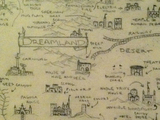A Map of Dreams
All of us have interior worlds that can be made visible.
by David Hoffman
The summer after my freshman year of college, I worked in a shop that sold laminated plaques: posters mounted on pieces of wood. The place also did custom work at a factory off-site, and one of the perks of my minimum-wage job was that at the end of the summer I could bring in one of my own items to be mounted at the factory. From the first day, I knew that what I would have mounted was a map of my dreams. I spent many of my free moments that summer creating the map.
I had been drawing dream maps for several years. I started with the idea that all of my dreams took place in the same Dreamland. Many of my dreams unfolded in familiar venues like my home and schools, so I placed them all in Dreamland in their appropriate locations. For places that seemed to exist only in my dreams, I had to use my intuition to place them on a map. I felt empowered to do this in part because a character in one of my dreams had once turned to me just before I woke up and said, “Anything learned about dreams while dreaming is true.” I loved that.
When a single location had been the site of multiple dreams, I gave the dreams names, like the titles of stories. I drew pictures of the buildings and landmarks I remembered, imitating the styles of the maps associated with my favorite books, like Tolkien’s Lord of the Rings series and Stephen R. Donaldson’s Chronicles of Thomas Covenant the Unbeliever. I finished that summer’s dream map in August and waited a few anxious weeks for it to come back from the factory.
Now thirty more summers have passed, and while I continue to treasure the dream map hanging on my wall, I have drawn no more of them. In some ways it feels as though the whole dream mapping enterprise belongs to a more innocent time in my life, when the routines and expectations of adulthood were more distant.
Yet the deepest lessons from my dream mapping have stayed with me, and shape my work with students and colleagues at UMBC: All of us know things we sense are deeply important, but do not derive from textbooks and authorities, or rational calculation. All of us have interior worlds that can help shape the exterior world if we feel empowered to connect the two. All of us can be creators, if we dare to know that our stories matter, and are worth making visible.
Yet the deepest lessons from my dream mapping have stayed with me, and shape my work with students and colleagues at UMBC: All of us know things we sense are deeply important, but do not derive from textbooks and authorities, or rational calculation. All of us have interior worlds that can help shape the exterior world if we feel empowered to connect the two. All of us can be creators, if we dare to know that our stories matter, and are worth making visible.
Co-Create UMBC is a blog for and about UMBC, written by David Hoffman and Craig Berger from Student Life. Join the Co-Create UMBC group on MyUMBC. Like Co-Create UMBC on Facebook. And follow David and Craig on Twitter.
Posted: August 26, 2015, 7:58 PM
